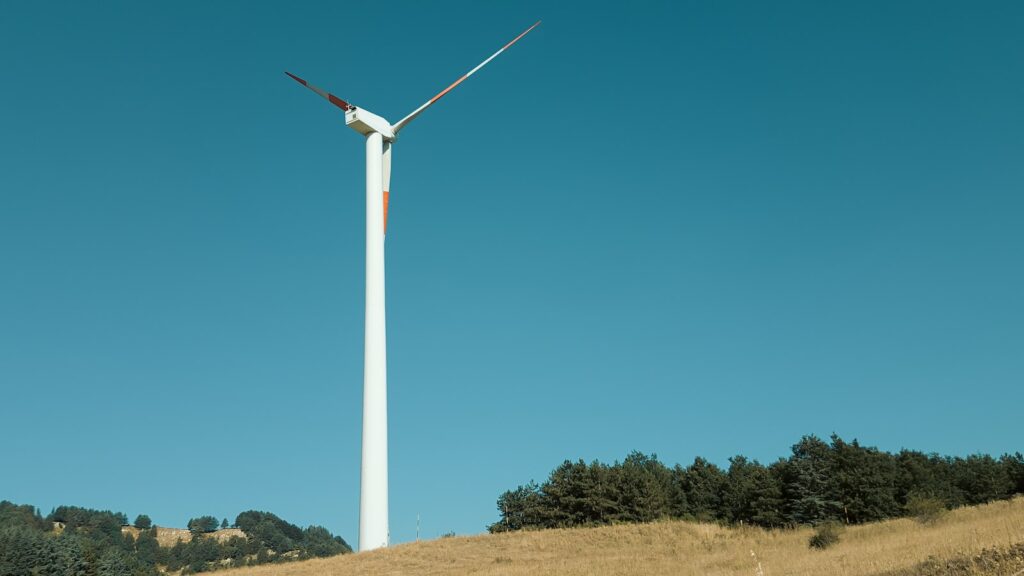Wind turbines are a type of renewable energy technology that harnesses the power of the wind to generate electricity. These large, vertical structures are typically made up of a tower, a rotor, and three blades.
They use the wind’s kinetic energy to turn the rotor, which drives a generator to produce electricity.
Wind turbines are an essential source of clean, renewable energy that can help reduce our reliance on fossil fuels and mitigate the negative impacts of climate change.
But have you ever noticed that many wind turbines have red lights? In this article, we’ll explore the purpose of these red lights, the benefits they provide, and the regulations surrounding their use.
What are wind turbines?
Wind turbines are a form of renewable energy that utilizes the kinetic power from the wind to generate electricity. These structures typically include a tower, rotor, and three blades.
The rotation of the turbine is powered by the wind, generating electricity via an electric generator.
Wind turbines provide an invaluable renewable energy alternative that can reduce the usage of non-renewable sources and lessen the consequences of global warming (International Renewable Energy Agency, 2020).
What are the different types of wind turbines?
Wind turbines come in two main varieties: horizontal-axis wind turbines (HAWTs) and vertical-axis wind turbines (VAWTs).
The most common type of turbine, HAWT, has three blades on a tower that rotates horizontally.
These turbines are typically used for large-scale, utility-grade wind energy projects (National Renewable Energy Laboratory, 2021).
VAWTs, on the other hand, have a vertical rotor with blades that rotate around a vertical axis.
These turbines are less common and are typically used for small-scale, residential wind energy projects (National Renewable Energy Laboratory, 2021).
The purpose of red lights on wind turbines
So why do wind turbines have red lights? The main purpose of these red lights is to improve aviation safety.
Wind turbines can pose a potential hazard to aircraft, as they are often located in areas with high levels of air traffic, such as near airports or along flight paths.
There is one way to reduce this risk; these structures must be equipped with lighting systems that make them more visible to pilots. (Federal Aviation Administration, 2021).
How do red lights on wind turbines improve aviation safety?
Red lights are commonly used on wind turbines for several reasons. First, red lights are highly visible and can be seen from a long distance, even in low-light conditions.
This makes them an effective way to alert pilots to the presence of wind turbines and help them avoid potential collisions (Federal Aviation Administration, 2021).
Second, red lights are less likely to interfere with pilots’ vision than other light colors.
White and blue lights, for example, can be more challenging to see in certain lighting conditions and cause glare or distractions for pilots (Federal Aviation Administration, 2021).
On the other hand, red lights are less intense and less likely to cause these issues.
Finally, red lights are often used on wind turbines because they are the color most easily distinguished from the natural background.
This makes them more effective at drawing attention to wind turbines and making them more visible to pilots (Federal Aviation Administration, 2021).
Benefits of using red lights on wind turbines
In addition to improving aviation safety, using red lights on wind turbines can provide several other benefits. One of these benefits is improved energy efficiency.
Red lights can help reduce the risk of aircraft collisions by making wind turbines more visible to pilots, which can result in costly damage and downtime for wind energy projects.
This can help improve wind energy projects’ overall efficiency and profitability (Federal Aviation Administration, 2021).
Using red lights on wind turbines can also help improve the aesthetics of wind energy projects.
Many people have concerns about the visual impact of wind turbines, and red lights can help mitigate these concerns by making wind turbines more visible and easier to identify.
This can help improve public acceptance of wind energy projects and make them more likely to be approved by local communities (Danish Wind Industry Association, 2020).
Regulations surrounding the use of red lights on wind turbines
The Federal Aviation Administration (FAA) in the United States regulates the use of red lights on wind turbines.
The FAA has established guidelines for lighting on wind turbines to ensure they are visible to pilots and do not risk aviation safety (Federal Aviation Administration, 2021).
How do these regulations impact the wind energy industry?
According to these guidelines, wind turbines must have a lighting system activated at night or during low visibility.
The lighting system must be visible from at least 3 miles away and consist of either red or white lights (Federal Aviation Administration, 2021).
Red lights are typically preferred because they are more easily distinguished from the natural background and are less likely to interfere with the vision of pilots (Federal Aviation Administration, 2021).
In addition to these guidelines, wind energy projects may also be subject to additional regulations and requirements set by local governments and regulatory agencies.
These regulations can vary depending on the wind turbine’s location and the air traffic level in the area (Danish Wind Industry Association, 2020).
How do wind turbines with red lights contribute to the goal of sustainable energy sources?
In conclusion, wind turbines have red lights for various reasons, including improving aviation safety, energy efficiency, and public acceptance.
These red lights are regulated by the Federal Aviation Administration and may also be subject to additional requirements set by local governments and regulatory agencies.
By using red lights on wind turbines, we can help ensure these renewable energy sources’ safe and efficient operation and work towards a more sustainable future.
References
- Danish Wind Industry Association. (2020). Wind turbine lighting. Retrieved from (https://www.windpower.org/en/technical-matters/turbine-technology/turbine-lighting/)
- Federal Aviation Administration. (2021). Wind turbine lighting. Retrieved from (https://www.faa.gov/airports/engineering/construction/guidance/design_standards/media/d08-11-05_wind_turbine_lighting.pdf)
- International Renewable Energy Agency. (2020). Wind energy. Retrieved from (https://www.irena.org/-/media/Files/IRENA/Agency/Publication/2019/Mar/IRENA_Wind_Energy_2019.pdf)







